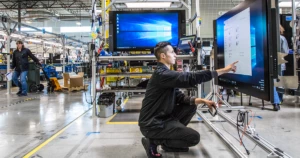
Building smarter banking branches with digital twins
 If you’re looking to make your next move toward intelligent banking, here’s an innovation that can help you deliver a more personalized customer experience for your branch clients.
If you’re looking to make your next move toward intelligent banking, here’s an innovation that can help you deliver a more personalized customer experience for your branch clients.
A digital twin is a digital replica of physical space, the processes that happen there, and the people moving through that space. It is the instantiation of a synchronized connection between the physical and the virtual.
The digital twin is a living simulation that receives near real-time updates from the physical world and can give feedback. Digital twins combine smart buildings, the Internet of Things (IoT), artificial intelligence (AI), analytics, graph networks, and big data to monitor and simulate the real world.
Digital twins can be used to:
- Monitor operations.
- Notify when more supplies need to be ordered.
- Take corrective action.
- Predict equipment failures.
- Run simulations.
- Deliver targeted advertising.
- Perform A/B testing.
- Apply discounts at checkout.
A new way of banking, enabled by digital twins
Customers flow through a bank branch just like products on a manufacturing floor, and their movement can be monitored by IoT devices and their phones. A digital twin can identity customers by their phones or using facial recognition in the branch (only for those who have opted in, of course).
Now, using the data collected by the digital twin, you can run simulations of branch traffic. Simulations allow you to do staffing plans and also play with branch layout. Will layout changes improve traffic flow or air flow, or will they increase social distancing?
Digital display advertising as part of a smart branch
When you know who your customers are and where they are, you can deliver targeted advertisements. For example, take a customer who has opted in to having their presence and social media monitored. A digital display in the branch detects the customer’s mobile phone passing by. The digital twin has noticed credit card purchases for newborn items such as a crib and a stroller. It has also checked their social media accounts and sees that they’re expecting a new baby.
On social media, the digital twin sees that a couple will soon have an empty nest. They are probably downsizing, looking for a smaller, more manageable home. By integrating branch data with bank data, new marketing and business opportunities emerge.
Branch business banking data knows neighborhood real estate agents. Ad displays can feature the latest mortgage rates, as well as local real estate agents that the branch customer could engage. The branch knows when the mortgage closes, and it can recommend home improvement loans, along with local contractors.
Now the contractor becomes the next banking customer. The branch displays business loans to the contractor as they enter the branch. The contractor needs the new loan to support their new work and to grow their business. Once the contractor gets the loan, the bank can advertise employee programs such as free personal banking for direct deposit for the contractor’s new employees, and the cycle starts over again.
All of this is possible when bank branches become the next digital twin.
Next steps
- Assess your branch’s infrastructure to understand what is IoT-enabled. Check video and cameras for real-time feeds. You can leverage the Microsoft smart building platform and smart building partners to help.
- In your banking app, ask customers to opt in and enable Bluetooth location-based services to understand the flow of people in your branch.
- Build out a proof of concept in a branch to see what insights a digital twin can deliver for your business. Microsoft can help.




